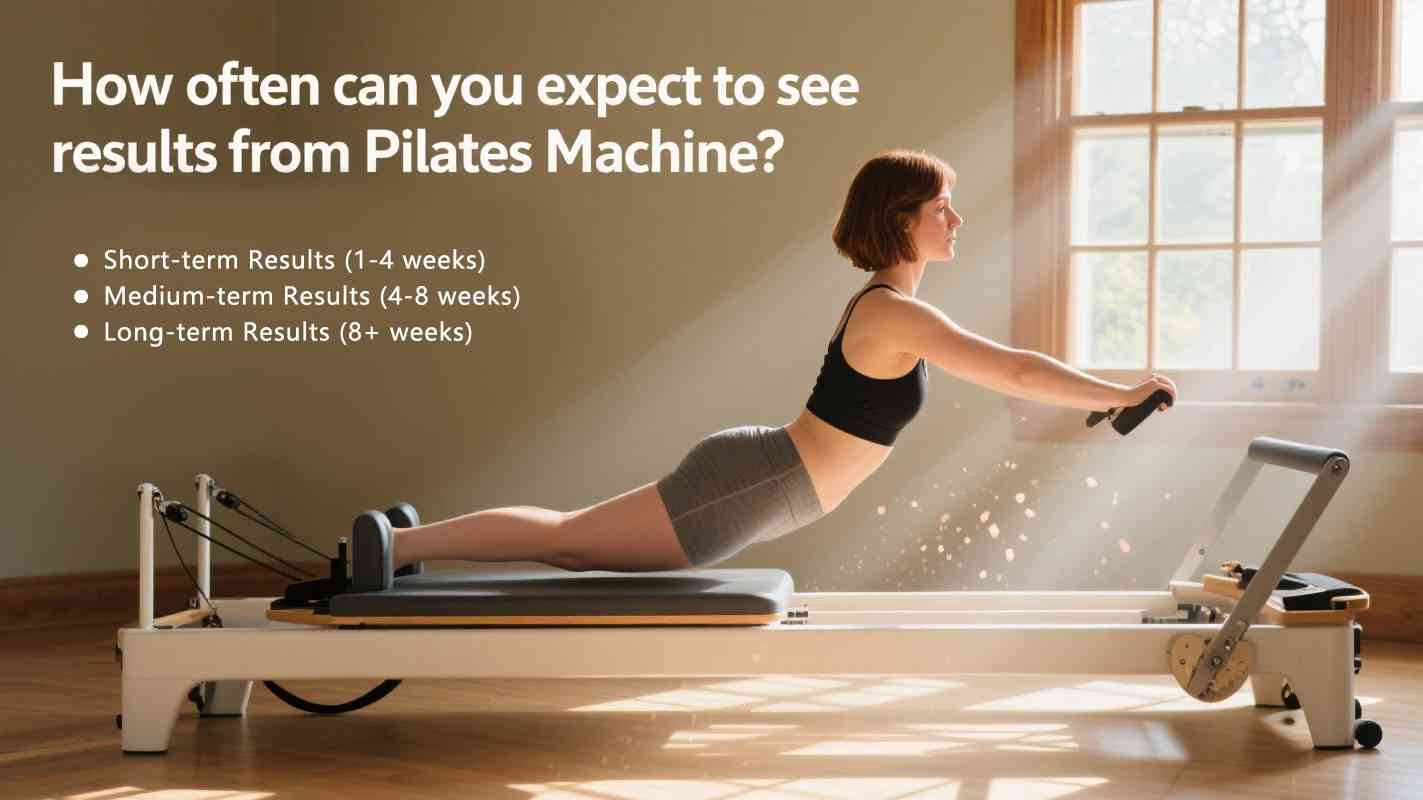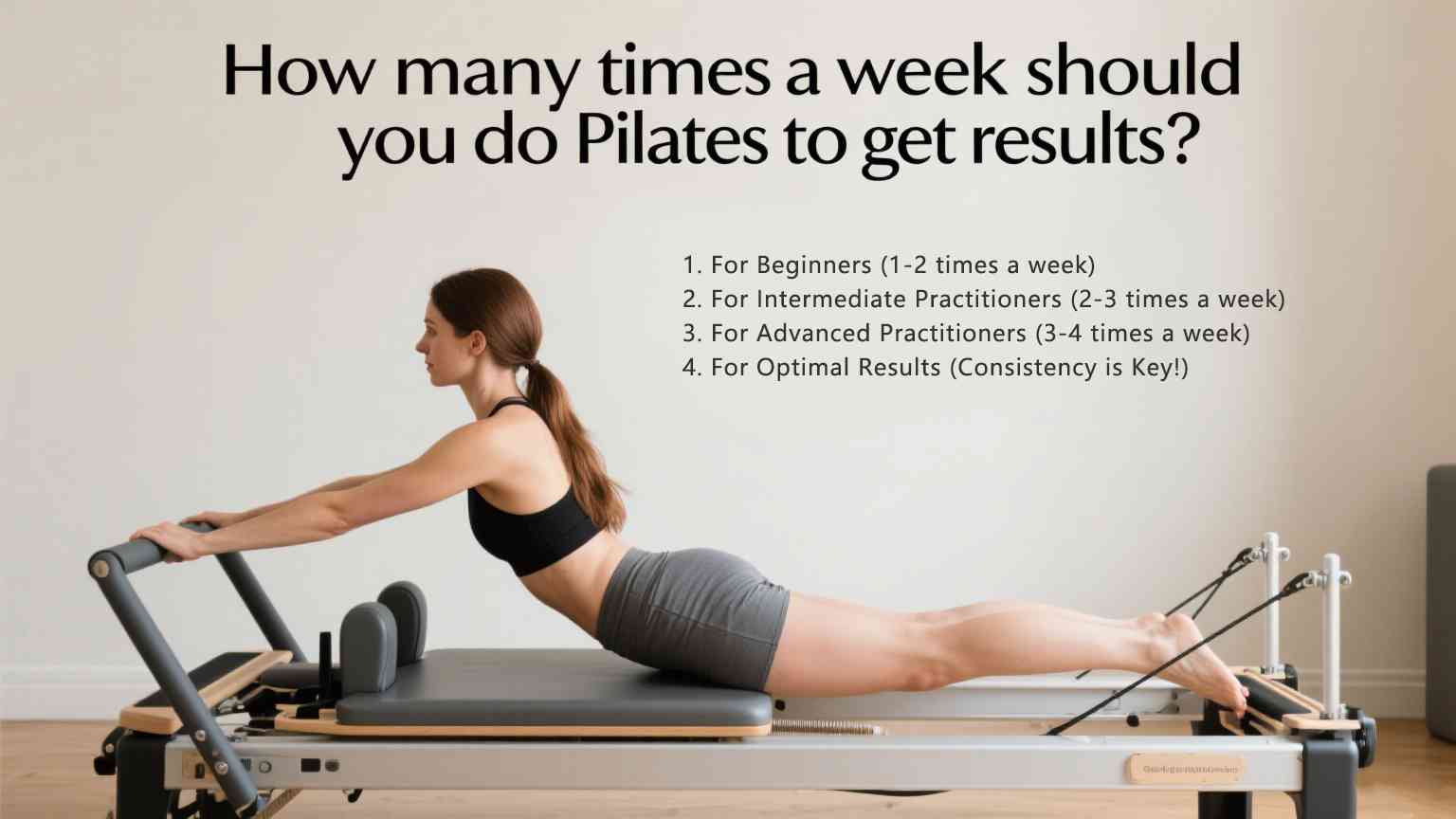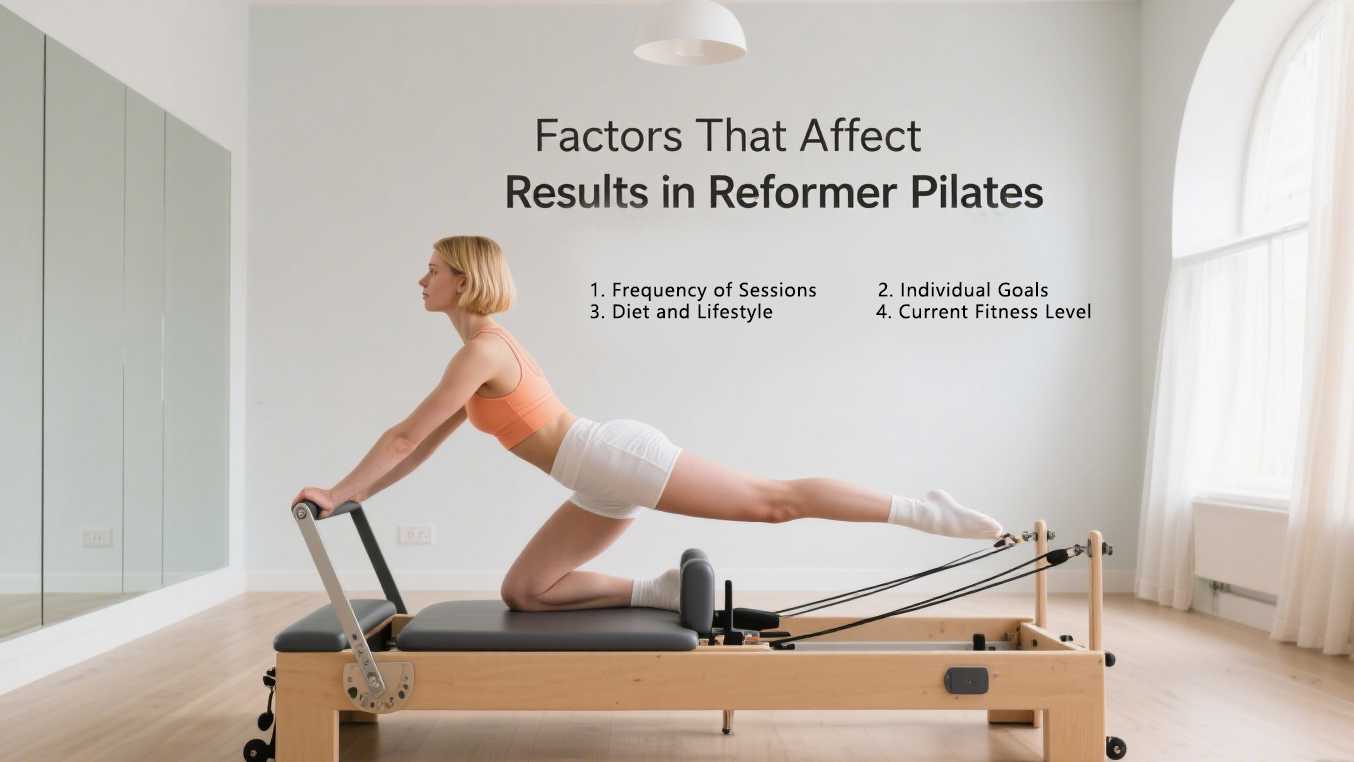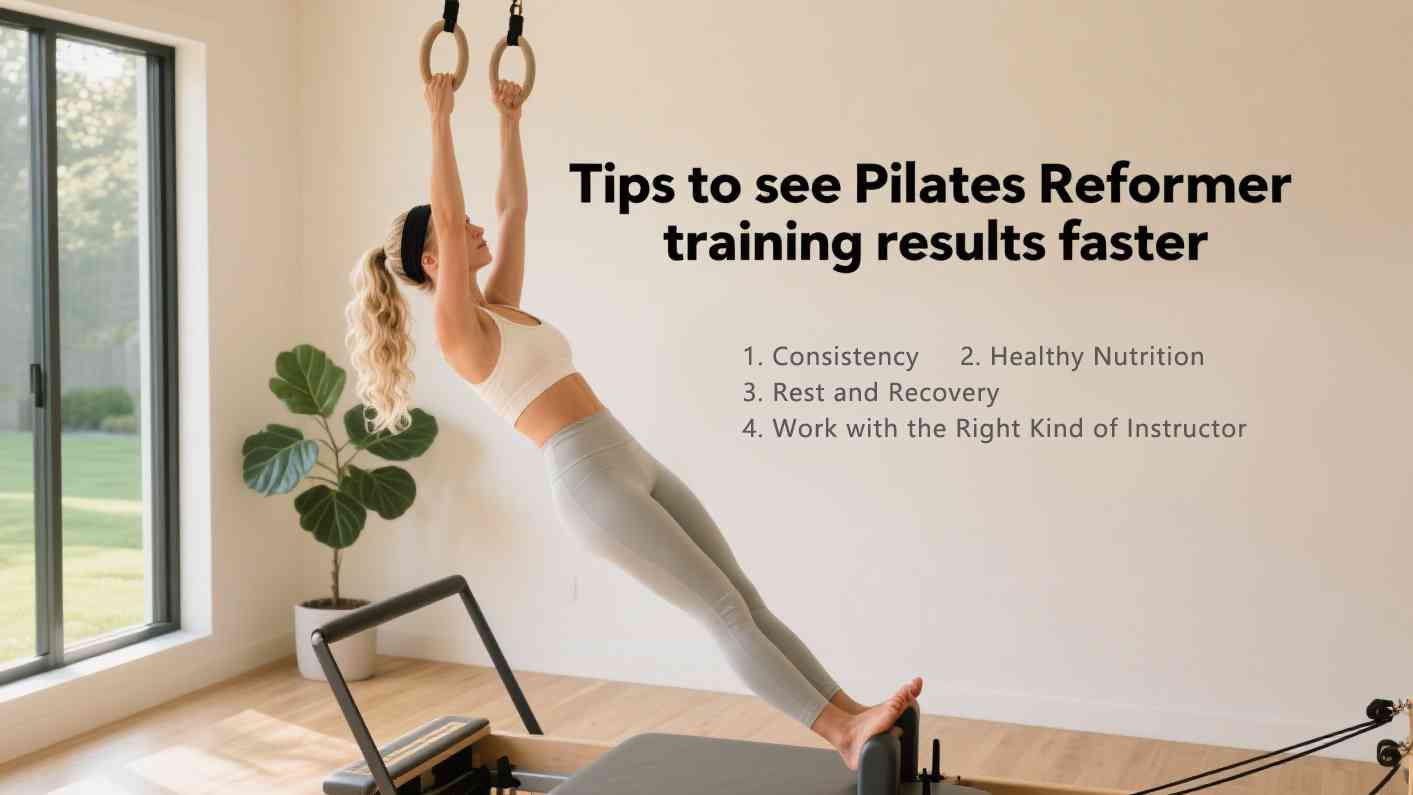When starting Reformer Pilates, you might wonder how long it takes to see results. Everyone's situation is different, but as long as you keep practicing. You can usually see improvements in strength, flexibility and posture within a few weeks. The key is regular practice and patience!
✅ How often can you expect to see results from Pilates Machine?

When it comes to Reformer Machine, the timeline for seeing results can vary depending on individual goals, consistency, and fitness level. Here's a breakdown of what you can typically expect at different stages:
Short-term Results (1-4 weeks)
In the first few weeks of consistent practice using a Pilates machine, you can expect to notice subtle improvements in flexibility, posture, and muscle activation. You may experience:
● Increased muscle engagement, especially in the core, legs, and arms.
● Improved posture, as the body learns to stabilize and align itself correctly.
● Greater body awareness through controlled movements, leading to a better understanding of how your body moves and feels during exercises.
● Slight improvements in flexibility, particularly in the lower back, hamstrings, and shoulders.
● Reduced tension in the body, especially for those who sit for long periods or have tight muscles.
At this stage, the results may not be visually noticeable, but you'll begin feeling stronger and more stable in your movements.
Medium-term Results (4-8 weeks)
After a few months of consistent practice with the Pilates machine, the results become more noticeable, especially if you're training 2-3 times a week. You may experience:
Visible muscle toning, particularly in the abdomen, thighs, and arms.
● Improved strength, especially in the core and lower body, as the muscles adapt to the resistance of the reformer.
● Increased flexibility with noticeable improvements in mobility and joint range of motion.
● Better balance and coordination, as your stabilizing muscles become stronger and more responsive.
● Enhanced endurance, allowing you to complete more challenging Pilates routines without feeling fatigued.
By this stage, many people start noticing visible changes in their muscle tone and feel more confident about their fitness journey.
| Time Frame | Results You Can Expect | Details |
| Short-term Results(1-4 weeks) | - Improved body awareness- Increased flexibility
- Better posture - Initial core activation |
- You may start feeling stronger and more aware of your posture.
- Flexibility improvements, especially in the hamstrings and lower back. - No visible muscle toning yet but you'll feel more stable in your movements. |
| Medium-term Results(4-8 weeks) | - Visible muscle toning
- Increased core strength - Enhanced flexibility - Better balance and coordination |
- Muscle definition begins to show, especially in the core, legs, and arms.
- Flexibility becomes more noticeable. - You'll feel stronger and more stable in your movements. |
| Long-term Results(8+ weeks) | - Significant muscle toning and definition
- Improved posture and alignment - Enhanced flexibility - Increased strength and endurance |
- Noticeable body transformation with defined muscles.
- Better posture and increased overall strength. - Flexibility and joint mobility continue to improve. - Greater overall wellness and mental clarity. |
Long-term Results (8+ weeks)
With consistent practice using a Pilates machine over the long term, typically after 8 weeks or more, you will begin to see more dramatic changes in both your body and overall fitness. This is where the most noticeable body transformations happen. You may experience:
● Significant muscle definition and toning, especially in the core, glutes, legs, and arms. Many people report a leaner, more sculpted physique.
● Improved posture becomes more permanent, leading to a more upright stance and less strain on your joints.
● Higher levels of strength and stability, with better control over your movements, both during workouts and in daily life.
● Increased flexibility, with a greater range of motion and less stiffness in your joints and muscles.
● Enhanced mind-body connection, making your movements feel more fluid and coordinated.
● Overall improved wellness, including better stress management, more energy, and an overall sense of vitality.
At this point, Reformer Pilates can lead to major body transformations that reflect your commitment and effort.
✅ How many times a week should you do Pilates to get results?
The frequency of Pilates practice required to see results can vary depending on your fitness goals, level of experience, and overall commitment. However, here’s a general guide to how many times a week you should do Pilates to get noticeable results:

1. For Beginners (1-2 times a week)
If you're new to Pilates or just starting out, practicing 1-2 times a week is a great way to ease into the practice. At this stage, your focus should be on learning proper form, understanding the exercises, and building a solid foundation.
● Results to Expect: Improved body awareness, better posture, and initial muscle engagement. You’ll feel more energized and your flexibility may begin to improve after a few weeks.
2. For Intermediate Practitioners (2-3 times a week)
As you become more familiar with Pilates, increasing your sessions to 2-3 times a week is ideal for building strength, flexibility, and improving overall fitness. This frequency allows you to challenge your body without overtraining.
● Results to Expect: Visible muscle toning, improved core strength, and better endurance. You may start seeing more muscle definition and a noticeable increase in flexibility and balance.
3. For Advanced Practitioners (3-4 times a week)
For more advanced results, training 3-4 times a week is typically required. This frequency will help you progress more rapidly and refine your technique while pushing your strength and flexibility to new levels.
● Results to Expect: Significant body transformation, increased muscle definition, improved stability, and flexibility. You will also develop a stronger mind-body connection and higher endurance.
| Aim | Number of sessions |
| Minimum requirement for improvements | 1 – 2 sessions per week |
| Moderate improvements | 2 – 3 sessions per week |
| Significant improvements | 3 – 4 sessions per week |
4. For Optimal Results (Consistency is Key!)
While practicing 4-5 times a week can be beneficial for advanced practitioners, consistency is more important than intensity. Focus on 2-3 sessions a week, and you can still achieve excellent results. Overtraining can lead to injury or burnout, so it's crucial to listen to your body and ensure you're allowing sufficient recovery time.
We are committed to delivering exceptional support and
top-tier service whenever you need it!
✅ Factors That Affect Results in Reformer Pilates
Here’s a detailed breakdown of the factors that affect results in Pilates equipment, such as the Pilates reformer or other apparatus:

1. Frequency of Sessions
The frequency of your Pilates sessions is a key factor in determining how quickly and effectively you’ll see results. Regular practice helps your body adapt to the challenges of Pilates equipment, building strength, flexibility, and muscle tone.
● For Beginners: Starting with 1-2 sessions per week allows you to become familiar with the equipment and learn proper form.
● For Intermediate or Advanced Practitioners: To see noticeable results, it’s recommended to practice 2-4 times per week. The more consistently you use Pilates equipment like the reformer, the faster you will develop strength, flexibility, and endurance.
● Recovery: Balance your sessions with adequate recovery time. Overtraining can lead to fatigue or injury, so make sure to rest and allow your muscles to recover between workouts.
2. Individual Goals
Your personal fitness goals significantly affect the results you can expect from Pilates equipment. Depending on whether you want to focus on strength, flexibility, weight loss, or injury rehabilitation, you’ll need to tailor your Pilates routine accordingly.
● Strength Goals: If building muscle strength is your goal, you will need to focus on resistance and intensity with your equipment (like adjusting the springs on a reformer).
● Flexibility and Mobility: If you’re aiming to improve flexibility or joint mobility, using the reformer’s adjustable resistance can help increase range of motion while stretching your muscles.
● Body Transformation and Weight Loss: Combining Pilates equipment with a balanced diet can lead to improvements in body composition. While Pilates isn't typically cardio-intensive, it supports fat loss through muscle toning, metabolic enhancement, and posture improvement.
● Injury Rehab: For those recovering from injuries, Pilates equipment can be a great way to gently build strength and improve muscle imbalances, especially in the lower back, hips, or shoulders.
3. Diet and Lifestyle
Diet and lifestyle play a vital role in supporting your Pilates results. While Pilates equipment can help you strengthen and tone muscles, the right diet and healthy lifestyle habits enhance your overall progress.
● Nutrition: Eating a balanced diet rich in protein, healthy fats, and fiber can help fuel your workouts and support muscle repair and growth. Proper nutrition also plays a crucial role in maintaining a healthy weight if that’s part of your goal.
● Hydration: Staying hydrated is essential for muscle function and recovery. Dehydration can slow down the recovery process and affect workout performance.
● Sleep and Recovery: Sleep is crucial for muscle recovery. Quality rest helps your body rebuild and strengthen muscles after workouts. A proper sleep routine supports overall performance and helps manage stress.
● Stress Management: Chronic stress can negatively impact results by elevating cortisol levels and affecting muscle recovery. Pilates has the added benefit of stress relief, but maintaining a balanced lifestyle outside of workouts can enhance the overall results.
4. Current Fitness Level
Your current fitness level will affect how quickly you see results with Pilates equipment. Beginners may need more time to build strength and flexibility, while those already fit may see faster results.
● Beginners: If you're new to exercise or Pilates, your body will undergo many foundational changes as you learn the movements. You may experience faster improvements in flexibility, posture, and body awareness. The focus will likely be on improving mobility, flexibility, and basic strength.
● Intermediate and Advanced: If you're already physically active or experienced in Pilates, you'll see more noticeable changes in muscle definition, core strength, and endurance. Advanced users will need to increase the intensity of their workouts, using more challenging equipment settings to continue progressing.
● Age and Injury History: Older individuals or those with prior injuries may experience slower progress, especially if they need to modify exercises for comfort or injury rehabilitation. However, Pilates equipment can be very beneficial for rehabilitation and can help improve joint function and muscle balance over time.
✅ Tips to see Pilates Reformer training results faster
Here are some tips for seeing Pilates Reformer results faster, focusing specifically on maximizing your progress with the Reformer machine:

1. Consistency
The key to faster results in using Pilates Reformer is consistency. The more often you use the Reformer, the quicker your body adapts and starts showing results.
● Regular Sessions: Aim for 2-4 Reformer sessions per week. This ensures you're consistently challenging your muscles and enhancing strength, flexibility, and coordination.
● Stay Dedicated: Make Pilates a routine part of your fitness schedule. While results may not be immediate, staying consistent will yield noticeable improvements over time.
● Gradual Progression: Consistency helps you progress from basic to more advanced movements on the Reformer. As your body becomes accustomed to the exercises, you'll be able to increase resistance and complexity.
2. Healthy Nutrition
What you eat plays a significant role in helping you achieve your Pilates Reformer results faster. Proper nutrition supports muscle repair, energy levels, and overall health.
● Protein for Muscle Repair: Pilates Reformer works your muscles intensely, so ensure you're getting enough protein to help with muscle recovery and growth. Include lean meats, fish, legumes, and plant-based proteins in your diet.
● Hydration: Drink plenty of water to stay hydrated. Dehydration can lead to muscle cramps and sluggish performance. Water also helps your muscles recover faster post-workout.
● Balanced Diet: Eat a balanced diet with whole grains, healthy fats, and plenty of fruits and vegetables. The right nutrients support energy levels for your Reformer workouts, so you perform at your best.
● Pre/Post Workout Nutrition: Have a small meal or snack rich in protein and carbs about 30 minutes before your session to fuel your body. After your session, replenish with protein to aid in muscle recovery.
3. Rest and Recovery
Adequate rest and recovery are crucial for making progress in Pilates Reformer. Your muscles need time to rebuild and strengthen after each session.
● Active Recovery: On non-Reformer days, engage in light activities such as walking, gentle yoga, or stretching. This keeps blood circulating and helps prevent stiffness.
● Sleep: Aim for 7-9 hours of quality sleep each night. Sleep is essential for muscle repair, energy replenishment, and overall recovery.
● Listen to Your Body: Don't overtrain. If you're feeling fatigued or overly sore, give yourself extra time to recover. Overtraining can lead to injury and slow your progress.
4. Work with the Right Kind of Instructor
Having an experienced Pilates instructor is key to getting the most out of your Reformer Pilates sessions and seeing faster results.
● Expert Guidance: A certified Pilates Reformer instructor will ensure that you're using the machine correctly and targeting the right muscle groups. Proper technique is crucial for effective results.
● Personalized Adjustments: A good instructor will provide feedback on your form, making sure you're engaging the right muscles and avoiding any harmful compensation patterns. This ensures you're maximizing the effectiveness of each exercise.
● Challenge and Progression: A skilled instructor will know when to challenge you by adjusting the resistance on the Reformer or suggesting more advanced exercises. Gradually increasing the difficulty ensures you're continuously progressing.
✅ Conclusion
Ready to transform your body with Reformer Pilates? Whether you’re aiming for better posture, muscle toning, or increased flexibility, the results are just a few sessions away. Commit to your practice and see the difference for yourself—start today!

Talk To Our Experts
Connect with an NQ expert to discuss your product needs
and get started on your project.
✅ FAQs
Can I see results by doing Reformer Pilates once a week?
While doing Reformer Pilates once a week can provide some benefits like improved flexibility and posture, consistent practice (2-3 times a week) is recommended for more noticeable results. You will see better improvements in strength, muscle tone, and endurance with more frequent sessions.
Is Reformer Pilates enough to tone your body?
Yes, Reformer Pilates can be effective in toning your body, especially when combined with a healthy diet and consistent practice. The resistance and controlled movements of the Reformer machine engage multiple muscle groups, which helps build strength and tone.
How much is too much reformer Pilates?
Too much Reformer Pilates can lead to overtraining, fatigue, and potential injury. Generally, 3-4 sessions per week is optimal for most people, allowing for sufficient recovery. It's important to listen to your body—if you're feeling sore or fatigued, it’s crucial to give your muscles time to recover before your next session.
Is it effective to do Reformer Pilates every day?
While Reformer Pilates every day can provide benefits, it's not recommended for most people, especially beginners or those who are still building muscle strength. Pilates involves intense muscle engagement, and recovery is key for muscle growth and injury prevention. Aim for 2-4 sessions per week, with rest days in between.
Does Reformer Pilates help with weight loss?
Reformer Pilates can contribute to weight loss, but it's not a cardio-intensive workout, so it works best when combined with a healthy diet and other calorie-burning activities like cardio. Pilates helps build muscle, and the more muscle you have, the higher your resting metabolic rate (RMR) will be, leading to more efficient calorie burning throughout the day.
Can Reformer Pilates change my body shape?
Yes, Reformer Pilates can help change your body shape by toning and sculpting muscles. The resistance provided by the reformer machine allows for targeted muscle engagement, especially in the core, glutes, legs, and arms. Over time, you may notice a more defined and toned body, improved posture, and enhanced muscle symmetry.
How can I combine Reformer Pilates with other exercises?
Reformer Pilates can be effectively combined with other exercises like cardio (e.g., running, cycling, swimming), strength training, or yoga to create a well-rounded fitness routine. Cardio helps burn fat, while Pilates enhances muscle tone and flexibility. Strength training can further improve overall muscle strength.
How long before you see results from Reformer Pilates?
You may start noticing improvements in strength and mobility within just a few sessions of reformer Pilates. For visible changes in your body, it typically takes around 12 weeks of consistent practice. The reformer is particularly effective for building abdominal strength, but it also offers overall benefits.
What are the common misconceptions about Reformer Pilates?
Common misconceptions about Reformer Pilates include thinking it’s only for women, when in fact it benefits both men and women. People also assume it’s easy, but it’s a challenging workout targeting deep muscles. Another myth is that it's just for stretching, while it actually builds strength, stability, and flexibility.
Post time: Jul-21-2025
